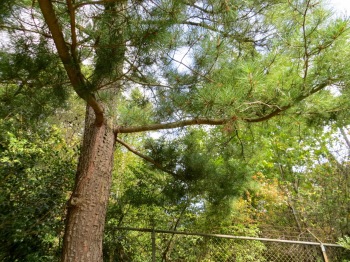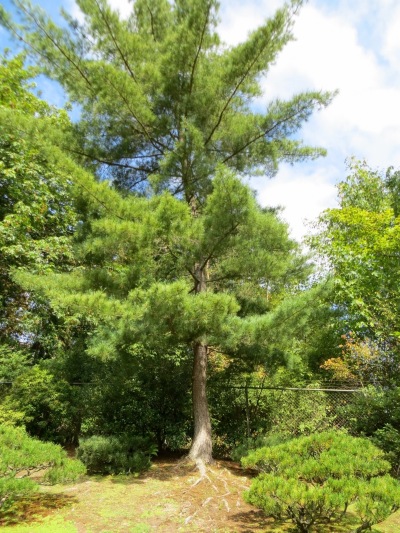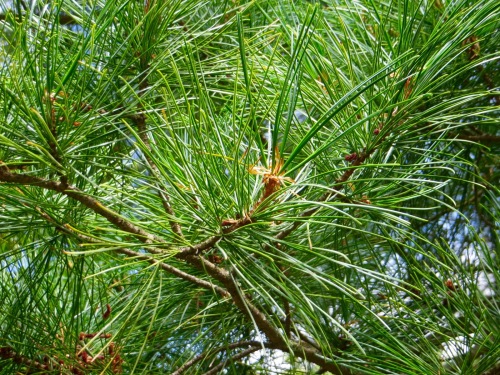Pinus • Pine • マツ • 松 • matsu
We have 3 trees listed as ‘Korean Pine’ in Area O, two of them, Pinus armandii x P. koraiensis, grow West of the Kobe lantern and seem to be Chinese white pines crossed with the Korean one (our Alpha lists describes them as ‘hybrid pines’), while the one described in this post, Pinus koraiensis (East of the Lantern), seem to be a true Korean Pine.
All three pines are approximately same size of 50′, and considering their fairly rare occurrence in our location*, their staged/group planting (the only one such types of pines in our Garden – all three on the hill in area O, visible together from many viewing places elsewhere in the Garden), I wonder if they were originally planted 55 years ago by Mr. Iida and what he would think seeing them in their current mature state…

SJG • 8/4/15 – Pinus koraiensis • Korean Pine in Area O, East of Kobe Lantern – note the upright growth habit
To add to confusion, USDA plant profile lists the tree’s name as: ‘Pinus koraiensis Siebold & Zucc.’ OR ‘Chinese pinenut’. Well, both Chinese and Korean pines are sources of cooking pennants, so…
All 3 trees in our Garden are long-needled, light-colored green, with large cones (although the true Korean pine has no cones this year), but their bark and growth habits differ: The Korean one has upright branches, while the hybrids have droopy/weeping branch pattern (the hybrids and their large cones were noticed by a recent visitor who inquired about them, prompting the Korean pine posts).
* the only source I could find for them was Japanese Maples and Evergreens, which specializes in ‘rare and hard to find Japanese Maple Trees, conifers, evergreens, bamboo and wisteria’ – the nursery seem to be located in Vancouver, WA, but I only got their location by sleuthing the internet, as their website has no info on location.
From wikipedia: […] The tree species Pinus koraiensis is commonly called Korean pine. It is native to eastern Asia: Korea, Manchuria, Mongolia, the Temperate rainforests of the Russian Far East, and central Japan. In the north of its range, it grows at moderate altitudes, typically 600 metres (2,000 ft) to 900 metres (3,000 ft), whereas further south, it is a mountain tree, growing at 2,000 metres (6,600 ft) to 2,600 metres (8,500 ft) altitude in Japan. It is a large tree, reaching a mature size of 40 metres (130 ft) to 50 metres (160 ft) height, and 1.5 metres (4.9 ft) to 2 metres (6.6 ft) trunk diameter.
It is a member of the white pine group, Pinus subgenus Strobus, and like all members of that group, the leaves (‘needles’) are in fascicles (bundles) of five,[citation needed] with a deciduous sheath. They are 7 centimetres (2.8 in) to 13 centimetres (5.1 in) long. Korean pine cones are 8 centimetres (3.1 in) to 17 centimetres (6.7 in) long, green or purple before maturity, ripening brown about 18 months after pollination.[…]
From Missouri Botanical Garden: […] Pinus koraiensis […] Grow in moist, well-drained loams in full sun. Tolerant of a wide range of soils, including both sandy and clay soils. Avoid poorly-drained wet soils. These trees prefer cool summer climates. They generally dislike the heat and humidity of hot and humid summer locations such the St. Louis area. They are noted for having excellent tolerance for cold winter temperatures (winter hardy to USDA Zone 3). […] Although uncommonly planted, Korean pine grows well in groups, as a screen or as a single specimen. […]
Interesting tidbit from Temperate Climate Permaculture: […]Permaculture Plants: Pine Trees for Pine Nuts
Common Name: Pine Tree, Pinion, Piñon, Pinyon, Stone Pine, Nut Pine
Scientific Name: Pinus species
Family: Pinaceae (the Pine family)
Common Species: there are about 115 Pine species, but only about 20 of them are useful for nut production. I have 16 of them listed below, and the most important Nut Pines (largest nuts, highest producers, easily found for planting, etc.) are in bold:
Chinese White Pine (Pinus armandii) – Asia
Lacebark Pine (Pinus bungeana) – Asia
Swiss Pine (Pinus cembra)
Mexican Pinyon, Mexican Pine Nut, Mexican Stone Pine (Pinus cembroides)
Coulter Pine (Pinus coulteri)
Colorado Pinion/Pinyon/Piñon, Rocky Mountain Piñon (Pinus edulis)
Chilgoza Pine (Pinus gerardiana) – Asia (western Himalayas)
Korean Nut Pine, Chinese Nut Pine (Pinus koraiensis)
Sugar Pine (Pinus lambertiana) – North America
Single-leaf Pinyon (Pinus monophylla) – North America
Italian Stone Pine, Umbrella Pine, Parasol Pine (Pinus pinea)
Siberian Dwarf Pine (Pinus pumila) – Asia
Parry Pinyon (Pinus quadrifolia) – North America
Gray Pine (Pinus sabineana) – North America
Siberian Pine (Pinus sibirica) – Asia
Torrey Pine (Pinus torreyana) – North America […]
From Plants For A Future: […] Pinus koraiensis – Siebold.&Zucc. • Medicinal Uses: […] The seed contains several medically active compounds and is analgesic, antibacterial and antiinflammatory. It is used in Korea in the treatment of earache, epistaxis and to promote milk flow in nursing mothers. The turpentine obtained from the resin of all pine trees is antiseptic, diuretic, rubefacient and vermifuge. It is a valuable remedy used internally in the treatment of kidney and bladder complaints and is used both internally and as a rub and steam bath in the treatment of rheumatic affections. It is also very beneficial to the respiratory system and so is useful in treating diseases of the mucous membranes and respiratory complaints such as coughs, colds, influenza and TB. Externally it is a very beneficial treatment for a variety of skin complaints, wounds, sores, burns, boils etc and is used in the form of liniment plasters, poultices, herbal steam baths and inhalers. The stem bark is used in the treatment of burns and skin ailments. […]



